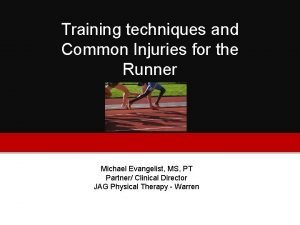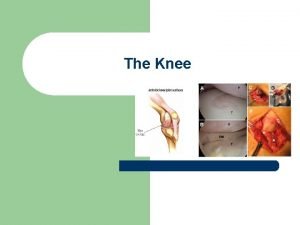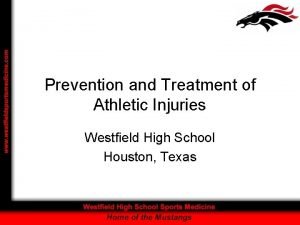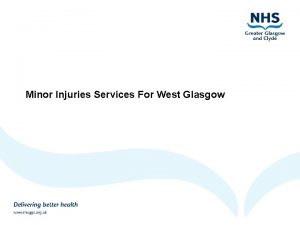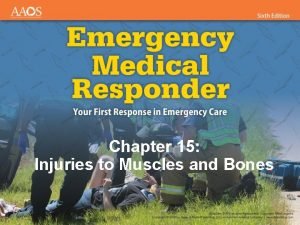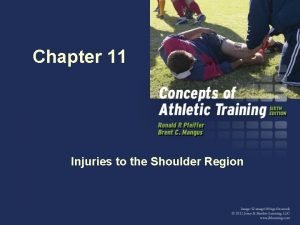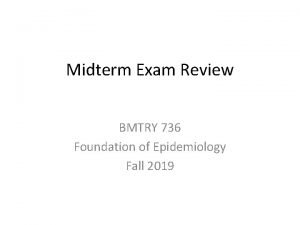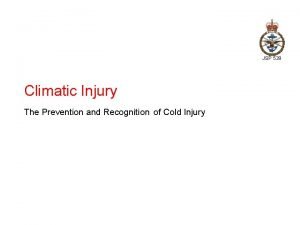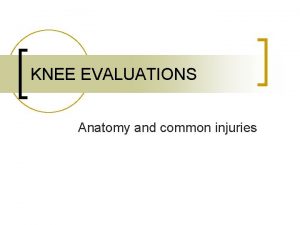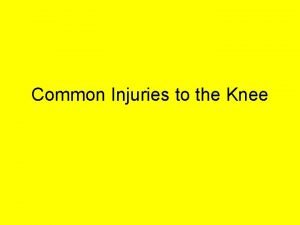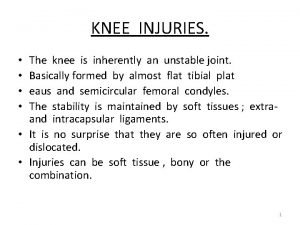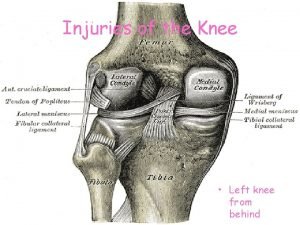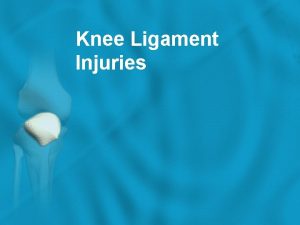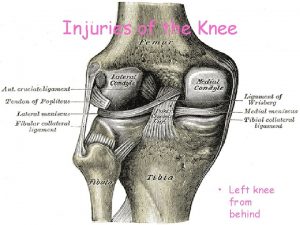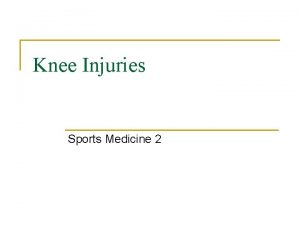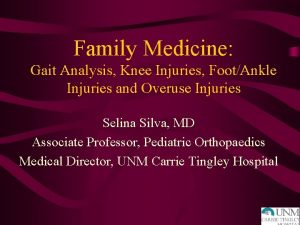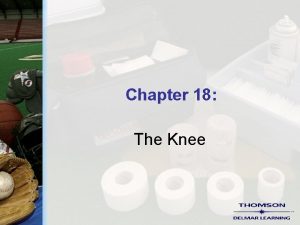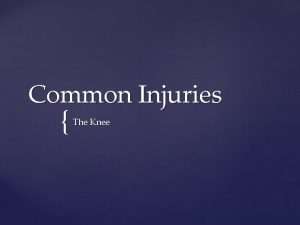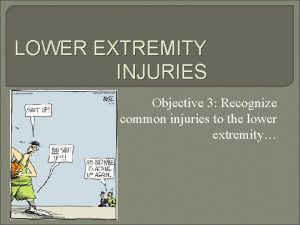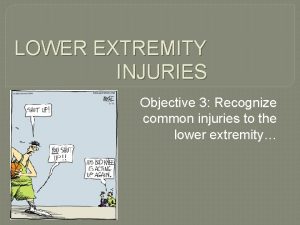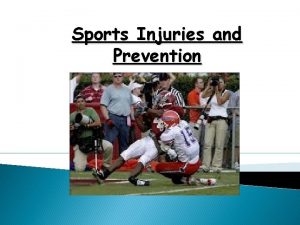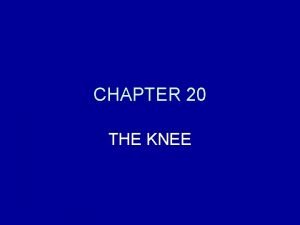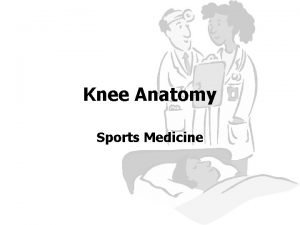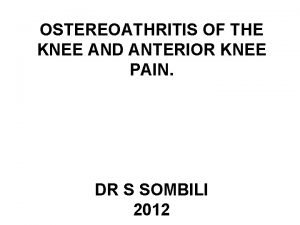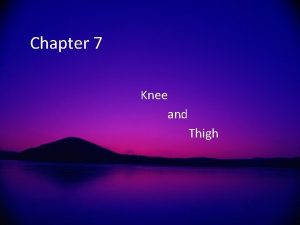Common Knee Injuries Knee Structure http theknee com

























- Slides: 25

Common Knee Injuries

Knee Structure (http: //theknee. com/)

Strength of the Knee (Stability) n The stability of the joint is based on all parts working together. Ligaments hold the joint in the correct position and the meniscus is the cartilage that sits between the bones acting as the shock absorber.

Ligament Tears n Grades n n n I : less than 1/3 of ligament fibers are damaged or torn II : between 1/3 and 2/3 of ligament fibers are damaged or torn III : more than 2/3 of ligament fibers are damaged or torn (usually ruptured!)

ACL Tear Anterior Cruciate Ligament

Anterior Cruciate Ligament n Orthopedic Test = Anterior Drawer Test

Posterior Cruciate Ligament (PCL)

Anterior Cruciate Ligament (ACL) Mechanism of Injury : hyperextension or changing directions quickly or slowing down quickly n Often hear a pop n

Posterior Cruciate Ligament (PCL) Mechanism of Injury : knee is forced backward n Dashboard Injury n

Posterior Cruciate Ligament (PCL) n Orthopedic Test : Posterior Sag Test

Lateral Collateral Ligament (LCL)

Lateral Collateral Ligament (LCL) n Mechanism of Injury : Varus force (force from inside causes ligament to rupture on lateral side)

Lateral Collateral Ligament (LCL) n Orthopedic Test : Varus Stress Test

Medial Collateral Ligament (MCL)

Medial Collateral Ligament (MCL) n Mechanism of Injury : Valgus force from outside forces ligament on inside to tear

Medial Collateral Ligament (MCL) n Orthopedic Test : Valgus Stress Test

Meniscal Tears can occur from TWISTING, Hyperflexion, or Hyperextension n This is the shock absorber of the knee – any damage can result in a weekend joint, pain, fluid and other issues. n

Types of n Meniscus n Tears n


Meniscus Tear n Orthopedic Test : Mc Murray’s

Patella Dislocation

Patella Dislocation n Patella dislocates LATERALLY n Orthopedic Test : Apprehension Test

Patellar Tendinitis (Jumper’s Knee)

IT Band Syndrome (Runner’s Knee)

IT Band Syndrome Caused by irritation of IT band n Pain is usually felt down in the lateral knee n Go by signs and symptoms n
 Bài thơ mẹ đi làm từ sáng sớm
Bài thơ mẹ đi làm từ sáng sớm Cơm
Cơm Common track injuries
Common track injuries L
L Http //mbs.meb.gov.tr/ http //www.alantercihleri.com
Http //mbs.meb.gov.tr/ http //www.alantercihleri.com Siat.ung.ac.id krs
Siat.ung.ac.id krs Tim madsen aspen
Tim madsen aspen Unit 15:8 providing first aid for cold exposure
Unit 15:8 providing first aid for cold exposure What is the physical condition of peeta and katniss?
What is the physical condition of peeta and katniss? Strickler spine and sport
Strickler spine and sport Westfield sports injuries
Westfield sports injuries Stobhill miu
Stobhill miu Human crutch two person drag
Human crutch two person drag A short backboard or vest-style immobilization
A short backboard or vest-style immobilization Chapter 21 caring for head and spine injuries
Chapter 21 caring for head and spine injuries Chapter 17:5 providing first aid for poisoning
Chapter 17:5 providing first aid for poisoning Chapter 15 injuries to muscles and bones
Chapter 15 injuries to muscles and bones Chapter 14:3 observing fire safety
Chapter 14:3 observing fire safety Chapter 14 bleeding shock and soft tissue injuries
Chapter 14 bleeding shock and soft tissue injuries Chapter 13:2 preventing accidents and injuries
Chapter 13:2 preventing accidents and injuries Chapter 11 injuries to the shoulder region
Chapter 11 injuries to the shoulder region Chapter 11 assessment and evaluation of sports injuries
Chapter 11 assessment and evaluation of sports injuries Kristen wilson injuries
Kristen wilson injuries Uc davis web scheduler
Uc davis web scheduler An epidemiologic survey of roller skating injuries
An epidemiologic survey of roller skating injuries Jsp539
Jsp539


